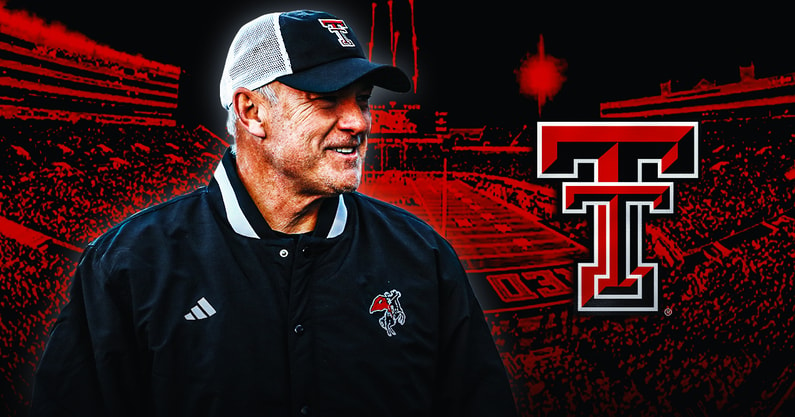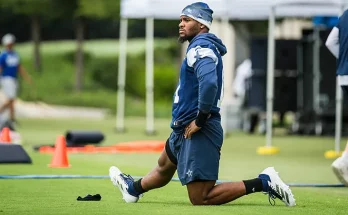Joey McGuire continues to make waves in the college football world, and this time it’s with his forward-thinking blueprint for Texas Tech’s 2026 recruiting class. The Red Raiders’ head coach recently opened up about his specific target numbers and positional goals for the upcoming cycle, giving fans, rivals, and analysts an unfiltered look into the program’s evolving strategy. The message was clear: Texas Tech is no longer satisfied with being competitive—they intend to contend.
Since his arrival in Lubbock, McGuire has infused Texas Tech football with energy, optimism, and structure. Now, as he lays out a meticulous roadmap for the 2026 recruiting cycle, he is doubling down on his philosophy of building from the trenches, staying Texas-tough, and locking down top-tier talent across every position group. Unlike vague coach-speak or recruiting clichés, McGuire’s clarity was refreshing—his recruiting targets weren’t just numbers, they were declarations of intent.
At the heart of McGuire’s 2026 vision is a commitment to balance. Rather than overloading on flashy skill positions, he is taking a methodical approach: securing depth where it matters most while still pursuing elite playmakers. According to McGuire, the staff is aiming for a recruiting class of around 22 to 24 players, aligning with what he calls “roster efficiency.” This number allows for long-term development, flexibility in the transfer portal, and the cultivation of foundational players who will contribute over multiple seasons.
One of the clearest statements McGuire made was his emphasis on the offensive and defensive lines. He wants at least five offensive linemen and four defensive linemen in the 2026 class, underscoring the importance of physical dominance. For a team striving to assert itself in a physical Big 12 and compete nationally, winning at the line of scrimmage is non-negotiable.
McGuire’s line-focused approach isn’t just about size—it’s about athleticism and versatility. He spoke about pursuing linemen who can move, adjust, and fit multiple schemes. The Red Raiders are targeting linemen with multi-sport backgrounds, especially those with wrestling or basketball experience, which typically translates to better footwork, leverage, and balance on the field.
Linebackers and defensive backs will also be a priority, with McGuire targeting three to four at each spot. The Big 12’s offensive diversity demands speed and intelligence at the second and third levels of the defense. McGuire mentioned the need for hybrid players—linebackers who can run sideline to sideline, safeties who can drop down into the box, and corners with length and recovery speed. The message is clear: adaptability is key.
On the offensive side, McGuire outlined his preference for taking two to three wide receivers and at least two running backs. But unlike the past, where numbers alone dictated decisions, he stressed the importance of fit. They’re not just seeking stats—they’re looking for players who fit the locker room culture, handle adversity well, and buy into the team-first mindset. Culture has become one of McGuire’s trademarks, and it’s evident in his recruiting criteria.
Quarterback recruiting is another critical piece, and McGuire didn’t shy away from discussing it. For 2026, he hopes to land one top-tier quarterback who can command the locker room and grow with the program. With the ever-changing transfer landscape, taking more than one QB in a class has become tempting for some programs. But McGuire is clear: he’d rather build around one highly-evaluated prospect and develop them properly than risk depth chart dysfunction.
One area where McGuire was particularly animated was special teams. Many coaches treat this phase of the game as an afterthought in recruiting, but McGuire emphasized the importance of securing a scholarship punter or kicker in 2026, depending on current roster needs. He highlighted several past games where special teams made the difference between winning and losing—details, he believes, that championship programs never ignore.
Beyond positions and numbers, what stood out in McGuire’s breakdown was his confidence and intentionality. He’s not just reacting to trends—he’s building a framework. He spoke candidly about the importance of relationships with high school coaches across Texas, noting that the Red Raiders aim to sign at least 80% of their class from within the state. That’s not just a number—it’s a philosophy rooted in loyalty, trust, and Texas pride.
McGuire also touched on how the Red Raiders are adapting to the NIL landscape. Rather than making hollow promises, the staff is educating recruits and families about the program’s infrastructure, alumni support, and Lubbock’s unique opportunities. He made it clear that Texas Tech will never be the school that leads with money—but it will be the school that develops players, supports them, and sets them up for long-term success.
Part of this strategy includes strategic use of the transfer portal. While the 2026 class will focus heavily on high school talent, McGuire emphasized that the staff is always evaluating where plug-and-play transfers might make sense. He expects the high school class to make up around 70% to 75% of the new additions, with the remaining slots held for proven talent that fits immediate needs.
Interestingly, McGuire’s vision also includes continued investment in player development. He outlined how Texas Tech’s strength and conditioning, nutrition, and academic support teams are all being aligned with recruiting objectives. This holistic approach makes sure that every player they bring in—whether a 5-star recruit or a 2-star sleeper—is given the tools to reach their ceiling.
As Texas Tech continues to grow under McGuire, his recruiting targets for 2026 are a blueprint of that ambition. His message to the Red Raider community and college football at large is unmistakable: this program is building something sustainable, something real, and something built to last. The transparency, confidence, and detail in McGuire’s breakdown reflects a coach who not only understands what it takes to win—but who also knows how to communicate that vision with clarity.
It’s also a signal to recruits and families across Texas and the country. If you want to be part of something that’s building with purpose—if you want to play meaningful football in front of passionate fans and under a staff that’s invested in you beyond Saturdays—then Texas Tech is making a compelling case.
McGuire ended his remarks by reinforcing that the 2026 class will be one of the most important in his tenure. With the shifting sands of college football, including conference realignment, media rights, and the expanded College Football Playoff, programs need depth, flexibility, and leadership more than ever. Texas Tech doesn’t want to just keep up—they want to lead.
As national attention continues to grow around Texas Tech’s recruiting efforts, one thing is for sure: Joey McGuire isn’t hiding behind vague optimism. He’s giving fans and recruits something tangible—specific goals, strategic clarity, and a vision of what the Red Raiders are becoming. The 2026 class won’t just be a group of athletes—it will be a statement of identity and intent.
Texas Tech football is aiming higher, planning smarter, and dreaming bigger. And under Joey McGuire, that dream is being built with discipline, detail, and an undeniable belief that the best days in Lubbock are just beginning.



